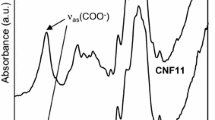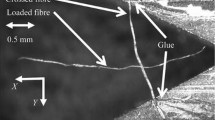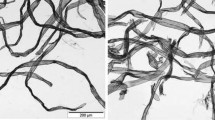Abstract
The total water capacity of a series of never-dried and re-wetted cellulosic fibres has been shown to correlate with the accessible volume described by a thermodynamic model. The model was applied to interpret the adsorption behaviour of a range of reactive dyes in electrolyte solutions and was successful in accounting for differences in fibre anionic charge. Comparative solute exclusion data indicated the existence of a population of very small spaces in never-dried cellulosic fibres, which may be associated with water disrupting the cellulose \({1\overline{1}0}\) crystal planes. Such intra-crystalline spaces may provide sites for uptake of planar substantive dyes and may also be accessible to sodium ions. The study showed that never-dried lyocell undergoes a large reduction in total wet capacity following initial drying, which is believed to be due to both exudation of crystal water and to inter-fibrillar crystallisation. This crystallisation mechanism may not be so effective for viscose and modal, which have poorer structural organization. Re-wetted lyocell exhibits high dye adsorption, which may result from the development of a uniform fibrillar morphology with a high surface area. This structural aspect is not expressed by the thermodynamic model.







Similar content being viewed by others
References
Weigel P, Fink H-P, Walenta E, Ganster J, Remde H (1997) Cell Chem Technol 31:321
Kaenthong S, Phillips SAD, Renfrew AHM, Wilding AM (2005) Colouration Technol 120(6):316
Bredereck K, Stefani H-P, Beringer J, Schulz F, Commarmot A (2003) Melliand Textilberichte 84(1–2):58
Kaenthong S, Phillips SAD, Renfrew AHM, Wilding AM (2005) Colouration Technol 121(1):45
Bredereck K, Gruber M, Utterbach A, Schulz F (1996) Textilveredlung 31:1
Vickerstaff T (1954) The physical chemistry of dyeing, Chap VII. Oliver and Boyd, London
Vickers ME, Briggs PN, Ibbett RN, Payne J, Smith SB (2000) Polymer 42:241
Abbott LC, Batchelor NS, Jansen L, Oakes J, Lindsay-Smith RJ, Moore NJ (2004) New J Chem 28(7):815
Sivaraja SR, Srinivasan G, Baddi TN (1968) Textile Res J (July):693
Sasaki H, Donkai N, Takagishi T (2004) Textile Res J 74(6):509
Bae S-H, Motomura H, Morita Z (1997) Dyes Pigments 34(1):37
Marshall WJ, Peters HR (1947) J Soc Dyers Colourists 63:446
Daruwalla HE, D’Silva AP (1963) Textile Res J 59:40
Sivarajalyer SR, Raghunath R (1989) Proc Natl Acad Sci India Sec A Phys Sci 59(1):37
Crawshaw J, Cameron ER (2000) Polymer 41(12):4691
Moss CE, Butler EC, Muller M, Cameron RE (2002) J Appl Polym Sci 83:2799
Bredereck K, Gruber M (1995) Melliand Textilberichte 76:684
Bredereck K, Schulz F, Otterbach A (1997) Mellian Textilberichte 78(10):103
Bredereck K, Saafan A (1981) Die Angewandte Makromolekulare Chemie 95:13 (Nr. 1482)
Stone EJ, Scallan MA (1968) Cellulose Chem Technol 2:343
Stone EJ, Scallan MA, Abrahamson B (1968) Svensk Papperstidning 71(19):187
Peters RH, Vickerstaff T (1948) Proc Roy Soc (Lond) A192:292
Carillo F, Lis JM (2002) Dyes Pigments 53:129
Ibbett RN, Phillips AD, Kaenthong S (2006) Dyes Pigments 71:168
Murtagh V, Taylor AJ (2004) Dyes Pigments 63:17
Morton WE, Hearle SWJ (1993) Physical properties of textile fibres, 3rd edn, Chap 10. William Heinemann Ltd, in association with The Textile Institute
Davidson GF (1948) J Textile Inst 39:T65
Kaewprasit C, Hequet C, Abidi N, Gourlot J-P (1998) J Cotton Sci 2:164
Lin KJ, Ladisch HM, Patterson AJ, Noller HC (1987) Biotechnol Bioeng 29:976
Gamma MF, Teixeira AJ, Mota M (1994) Biotechnol Bioeng 43:381
Squire PG (1981) Chromatogr J 210:433
Dork L, Sahagian D, Proussevitch A (1998) J Volcanol Geoth Res 84:173
Fras L, Laine J, Stenius P, Stana K-Kleinschek, Ribitsch V, Dolece V (2004) J Appl Polym Sci 92:3186
McGregor R (1972) Textile Res J 68:536
Fink H-P, Weigel P, Purs JH, Ganster J (2001) Prog Polym Sci 26:1473
Dube M, Blackwell HR (1983) TAPPI Proceedings of the international conference on dissolving and speciality pulps, Jan 1983
Bredereck K (2005) Rev Prog Colouration 35:39
Peter H, Priest MH (1968) In: Mark HF, Atlas SM, Cernia E (eds) Man-made fibers: science and technology, Vol II, Chap 2. Interscience Publishers, New York
Moncrief WR (1970) Man-made fibres, 5th edn, Chap 13. Haywood Books, London
Fujita H (1990) Polymer solutions: studies in polymer science, Vol 9, Chap 10.2. Elisvier BV
Ibrahim MD, Mondal H, Akira K (2001) . J Appl Polym Sci 79:1726
Franks EN, Varga JK (1980) US Patent No. 4,196, April 1980, 282
Lenz J, Schurz J, Eichinger D (1994) Lenziner Berichte 9:19
Lenz J, Schurz J, Wrentschur E (1992) Acta Polym 43:12
Porter JJ (1993) Textile Chemist Colourist 25:4
Yang Y, Lan T, Li S (1995) Textile Chemist Colourist 27(2):29
Ibbett RN, Phillips AD, Kaenthong S (available online 28th Sept 2006) Dyes Pigments
Acknowledgements
The authors would like to thank The Christian Doppler Society for financial support, and also Lenzing AG, for financial support and for supply of fibre samples. Thanks also to Dr Christian Schuster for helpful discussions.
Author information
Authors and Affiliations
Corresponding author
Rights and permissions
About this article
Cite this article
Ibbett, R.N., Kaenthong, S., Phillips, D.A.S. et al. Solute adsorption and exclusion studies of the structure of never-dried and re-wetted cellulosic fibres. J Mater Sci 42, 6809–6818 (2007). https://doi.org/10.1007/s10853-006-1426-4
Received:
Accepted:
Published:
Issue Date:
DOI: https://doi.org/10.1007/s10853-006-1426-4




